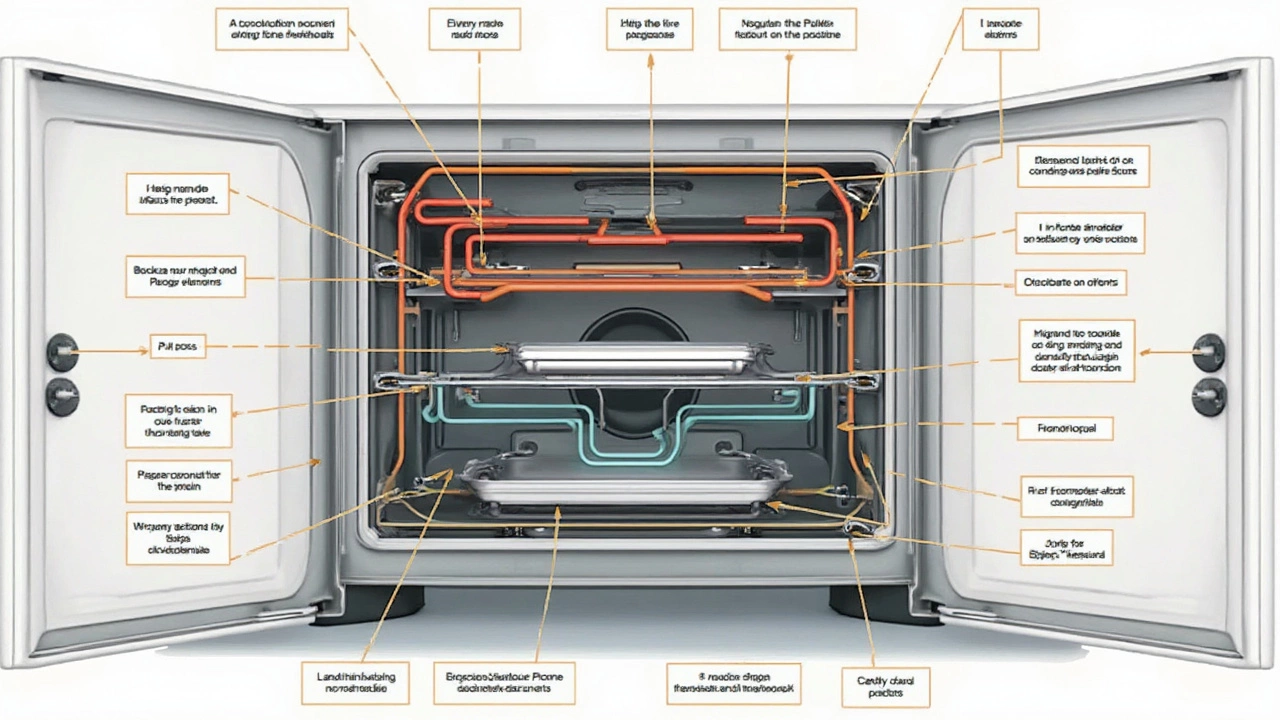Electric ovens are part of our everyday routines, yet they're also prone to troubles that can catch us off guard. One of the most common headaches? An oven that just won't heat up. Imagine preheating it for dinner, only to find that it’s lukewarm an hour later. Frustrating, right?
This can often be traced back to something as simple as a faulty heating element or a glitchy thermostat. Knowing what to check first can often mean the difference between a quick DIY fix and calling in the pros.
And it's not just heating issues—door seals can wear out over time as well, letting precious heat escape, or you might be facing electrical problems like circuits that trip more than a clumsy waiter. These aren't always signs your oven is toast; sometimes, they’re just a cry for a bit of maintenance love.
Heating Problems
So, your electric oven problems include a dinner that's always fashionably late? You're not alone. One of the most common issues faced by electric oven owners is inconsistent or insufficient heating. Let's dig into what might be going wrong and how you can fix it before your appetite goes cold.
Faulty Heating Elements
The heating elements in your oven are the rockstars of the cooking world. They need to be in top shape to deliver the perfect performance. If your oven's not heating properly, the elements could be burnt out or damaged. Replacing a heating element is usually straightforward and can often be done without professional help.
Thermostat Problems
The thermostat is the brain behind your oven's heating system, responsible for maintaining the desired temperature. If it malfunctions, your oven might be heating unevenly or not reaching the set temperature at all. Thermostat issues can often be resolved by recalibrating or replacing the sensor.
Power Supply Issues
Sometimes, it's not the oven itself but the power supply that's playing tricks. A quick way to diagnose this is to check other appliances on the same circuit. If they’re out too, you might have tripped a breaker or blown a fuse. Head to the fuse box to see if you can flick things back into shape.
DIY Troubleshooting Steps
- Check the heating elements: Look for signs of wear or visible damage. A part of the element that looks browner than the rest indicates burnout.
- Test the thermostat: Use an oven thermometer to see if the internal temperature matches the setting. If not, your thermostat might need resetting.
- Inspect power cords and outlets: Ensure everything is plugged in securely, and there's no visible damage or scorching.
When in doubt, don’t be afraid to call in a professional—especially if electrical issues are on the table. Safety first!
Common oven issues can be a real downer when you’re ready to throw down with your cooking skills. By understanding what might be going wrong and tackling it head-on, you can keep your oven in top form and your meals on time.
Thermostat Malfunctions
Imagine setting your electric oven to 350 degrees, but your cookie dough ends up like inedible bricks. Blame the thermostat. This little device is the brain of your oven, constantly measuring temperature and telling the heating elements what's what. When it goes kaput, chaos ensues.
How to Spot a Faulty Thermostat
A common sign is an oven that won't reach or maintain the set temperature. If your dishes are turning out overcooked or half-baked, it's time to take a closer look. Using an oven thermometer can help you verify if the actual temperature matches what you've set.
DIY Fixes Before Calling the Pros
Before reaching out for help, try resetting your oven. Simply unplug it for a minute and plug it back in. It sounds too easy, but resetting can sometimes jolt things back into gear. If the problem persists, it might be time to replace the thermostat.
"Don't underestimate the small parts—they drive the big outcomes." – Appliance Repair Specialist
When to Seek Professional Help
If you're not comfortable handling wiring or dismantling panels, get a professional. Messing with electronics can be tricky and potentially dangerous without the right know-how.
Cost Considerations
Replacing an oven thermostat can often be relatively inexpensive, but labor costs can add up. Being informed and knowing exactly which component to replace can sometimes save you a decent amount of cash.
Ensuring your oven problems get the right diagnosis can avoid long-term hassles and keep your baking journeys smooth sailing!

Door Seal Issues
Door seal issues might not sound like a big deal, but they can lead to some serious headaches in the world of electric oven problems. When a seal wears out, it doesn’t just lead to a slightly cooler meal. Nope, it can cause your energy bills to climb while the performance of your electric oven takes a dive.
Spotting the Culprit
Wondering how to tell if the door seal is the troublemaker? Check if the door closes tightly. A simple test involves placing a strip of paper between the door and the seal, then closing the door. If you can pull it out without resistance, the seal may need replacing.
Why Seals Fail
Seals degrade over time due to heat, food particles, and even frequent use, making them less effective. Checking them every once in a while can help catch problems early. Funny enough, door seals aren't something most folks think about until there's an issue.
Changing the Seal
If replacing the seal seems intimidating, don't sweat it. It’s usually a straightforward process. Here's a quick guide:
- First, find a replacement seal that matches your oven model. Brand ensures compatibility.
- Next, pull the old seal away from the oven door gradually, taking note of how it fits.
- Then, simply press the new seal into the groove, ensuring it's snug and even all around.
This fix not only boosts performance but can save cash on exaggerated energy use.
A quick maintenance fix like this can be the difference between a mildly undercooked lasagna and a perfect one. So, before blaming your cooking skills, consider giving your oven door seal a little check-up!
Electrical Surges
You might not think about it much, but electrical surges can wreck havoc on your electric oven. Picture this: a sudden jolt of electricity rushes through your home's wiring, and your oven's delicate circuits and components take the hit. Sounds scary? It can be.
These surges can be caused by a variety of things, from lightning strikes to simple overloaded circuits in your house. Sometimes, it's just the utility company doing maintenance work. Either way, your electric oven doesn’t appreciate the surprise power surge.
What to Do About It
First things first, a surge protector can be your oven's best friend. They're pretty affordable and act like a helmet for your electric appliances, diverting extra electricity away. You’ll find them in most hardware stores, and they're super easy to install.
If you suspect a bigger problem, it might be time to get an electrician involved. They can help ensure all your connections are solid, perhaps even suggesting whole-home surge protection—a smart move if you're experiencing regular power blips.
Signs You’ve Been Hit by a Surge
- Suddenly, the oven won't heat up or turns off unexpectedly.
- There's a burnt smell, though this could also indicate other issues.
- Display shows error messages or goes blank entirely.
If your electric oven shows these signs after a storm or when your power's been finicky, it could likely be an electrical surge. A quick assessment could save you lots of time and money in the long run.

Simple Maintenance Tips
Keeping your electric oven in tip-top shape doesn't have to be rocket science. In fact, just a few regular checks can help prevent those annoying problems that always seem to pop up at the worst time. So, how can you keep your trusty kitchen companion running smoothly?
Regular Cleaning
First things first, cleanliness is key. An oven full of crumbs and grease can lead to uneven heating or even smoke. Make it a habit to give your oven a wipe-down after every use. Use a damp cloth and some mild detergent to avoid leaving any residues that might burn off later.
Inspecting the Door Seal
Check the door seal regularly. If it's worn out or cracking, heat might escape, which can drastically affect cooking times. Just run your hand along the edge when the oven's on and feel for escaping warmth. If there’s any sign of trouble, consider replacing the seal. It’s a small fix that can make a big difference.
Tackling Heating Elements
If your oven isn't heating properly, take a peek at the heating elements. Are they glowing nice and bright? If not, give them a gentle clean or consider replacing them. It can be as simple as unscrewing a couple of bolts.
Sensor and Thermostat Checks
Another part to keep an eye on is the thermostat sensor. Malfunctions here can lead to inaccurate temperature readings. A quick calibration might be all it takes. Use an oven thermometer to test if your oven’s temperature aligns with your settings. If there’s a mismatch, it might be time to call in some professional help.
Electrical Connections
Lastly, don’t forget the electrical side of things. Electric ovens are, well, electric. So, check your power connections and ensure everything’s plugged in tight. Look out for any frayed wires and always unplug the oven before you do any poking around.
By keeping an eye on these parts and performing regular checks, you can fend off most common oven issues before they turn into big problems. After all, a stitch in time saves nine, right?


